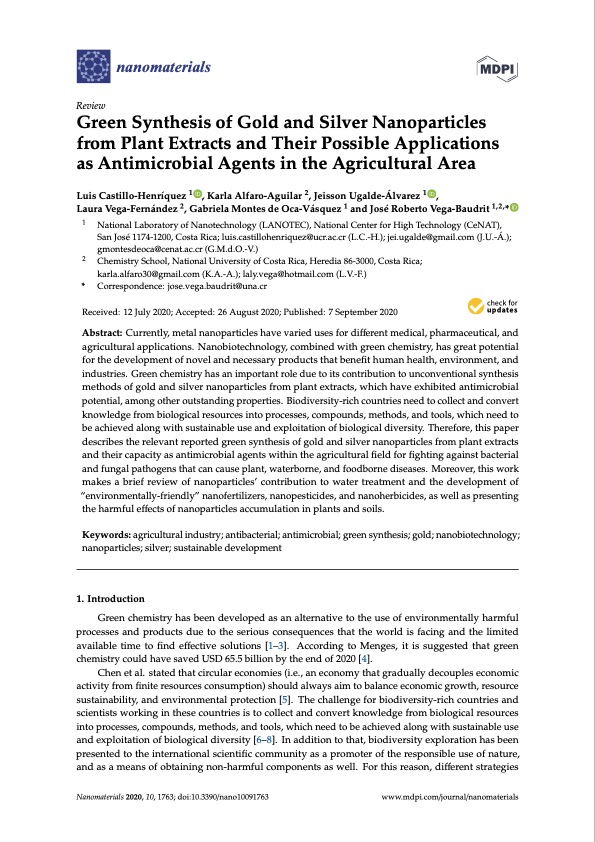
PDF Publication Title:
Text from PDF Page: 001
nanomaterials Review Green Synthesis of Gold and Silver Nanoparticles from Plant Extracts and Their Possible Applications as Antimicrobial Agents in the Agricultural Area Luis Castillo-Henríquez 1 , Karla Alfaro-Aguilar 2, Jeisson Ugalde-Álvarez 1 , Laura Vega-Fernández 2, Gabriela Montes de Oca-Vásquez 1 and José Roberto Vega-Baudrit 1,2,* 1 National Laboratory of Nanotechnology (LANOTEC), National Center for High Technology (CeNAT), San José 1174-1200, Costa Rica; luis.castillohenriquez@ucr.ac.cr (L.C.-H.); jei.ugalde@gmail.com (J.U.-Á.); gmontesdeoca@cenat.ac.cr (G.M.d.O.-V.) Chemistry School, National University of Costa Rica, Heredia 86-3000, Costa Rica; karla.alfaro30@gmail.com (K.A.-A.); laly.vega@hotmail.com (L.V.-F.) 2 * Correspondence: jose.vega.baudrit@una.cr Received: 12 July 2020; Accepted: 26 August 2020; Published: 7 September 2020 Abstract: Currently, metal nanoparticles have varied uses for different medical, pharmaceutical, and agricultural applications. Nanobiotechnology, combined with green chemistry, has great potential for the development of novel and necessary products that benefit human health, environment, and industries. Green chemistry has an important role due to its contribution to unconventional synthesis methods of gold and silver nanoparticles from plant extracts, which have exhibited antimicrobial potential, among other outstanding properties. Biodiversity-rich countries need to collect and convert knowledge from biological resources into processes, compounds, methods, and tools, which need to be achieved along with sustainable use and exploitation of biological diversity. Therefore, this paper describes the relevant reported green synthesis of gold and silver nanoparticles from plant extracts and their capacity as antimicrobial agents within the agricultural field for fighting against bacterial and fungal pathogens that can cause plant, waterborne, and foodborne diseases. Moreover, this work makes a brief review of nanoparticles’ contribution to water treatment and the development of “environmentally-friendly” nanofertilizers, nanopesticides, and nanoherbicides, as well as presenting the harmful effects of nanoparticles accumulation in plants and soils. Keywords: agricultural industry; antibacterial; antimicrobial; green synthesis; gold; nanobiotechnology; nanoparticles; silver; sustainable development 1. Introduction Green chemistry has been developed as an alternative to the use of environmentally harmful processes and products due to the serious consequences that the world is facing and the limited available time to find effective solutions [1–3]. According to Menges, it is suggested that green chemistry could have saved USD 65.5 billion by the end of 2020 [4]. Chen et al. stated that circular economies (i.e., an economy that gradually decouples economic activity from finite resources consumption) should always aim to balance economic growth, resource sustainability, and environmental protection [5]. The challenge for biodiversity-rich countries and scientists working in these countries is to collect and convert knowledge from biological resources into processes, compounds, methods, and tools, which need to be achieved along with sustainable use and exploitation of biological diversity [6–8]. In addition to that, biodiversity exploration has been presented to the international scientific community as a promoter of the responsible use of nature, and as a means of obtaining non-harmful components as well. For this reason, different strategies Nanomaterials 2020, 10, 1763; doi:10.3390/nano10091763 www.mdpi.com/journal/nanomaterialsPDF Image | Green Synthesis of Gold and Silver Nanoparticles from Plant Extracts

PDF Search Title:
Green Synthesis of Gold and Silver Nanoparticles from Plant ExtractsOriginal File Name Searched:
nanomaterials-10-01763.pdfDIY PDF Search: Google It | Yahoo | Bing
Turbine and System Plans CAD CAM: Special for this month, any plans are $10,000 for complete Cad/Cam blueprints. License is for one build. Try before you buy a production license. More Info
Waste Heat Power Technology: Organic Rankine Cycle uses waste heat to make electricity, shaft horsepower and cooling. More Info
All Turbine and System Products: Infinity Turbine ORD systems, turbine generator sets, build plans and more to use your waste heat from 30C to 100C. More Info
CO2 Phase Change Demonstrator: CO2 goes supercritical at 30 C. This is a experimental platform which you can use to demonstrate phase change with low heat. Includes integration area for small CO2 turbine, static generator, and more. This can also be used for a GTL Gas to Liquids experimental platform. More Info
Introducing the Infinity Turbine Products Infinity Turbine develops and builds systems for making power from waste heat. It also is working on innovative strategies for storing, making, and deploying energy. More Info
Need Strategy? Use our Consulting and analyst services Infinity Turbine LLC is pleased to announce its consulting and analyst services. We have worked in the renewable energy industry as a researcher, developing sales and markets, along with may inventions and innovations. More Info
Made in USA with Global Energy Millennial Web Engine These pages were made with the Global Energy Web PDF Engine using Filemaker (Claris) software.
Infinity Turbine Developing Spinning Disc Reactor SDR or Spinning Disc Reactors reduce processing time for liquid production of Silver Nanoparticles.
| CONTACT TEL: 608-238-6001 Email: greg@infinityturbine.com | RSS | AMP |